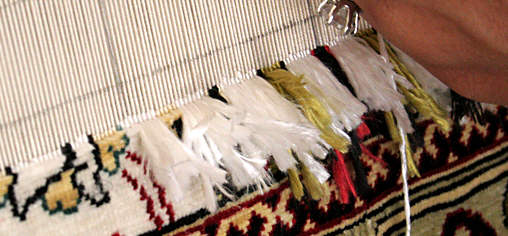
There is a concern that that art of weaving oriental rugs may be threatened by various factors. We visited a co-op. To quote from their website (sultankoy.info)....
Founded in 1987 in Camlik Village,
Sultankoy was established with the intention
of protecting, developing, and the marketing
of the art of carpet weaving as well as
increasing the social strength of the local
population through agricultural practices.
They gave us a tremendous introduction to oriental carpets (and opportunies to acquire anything from a small, inexpensive momento, up to serious works of art. One member of our group had brought measurements for three large rooms, and went away very happy.)
(If at any point you decide that you know as much as you wish to about our visit to the Sultankoy Carpet Co-op, do at least skip down to the penultimate photo on the page...)
The information was comprehensive and interesting, and the people doing the presentation were very professional, and worked hard... not least physically, rolling out many, many carpets to illustrate points they were making.
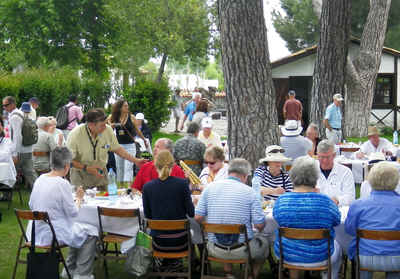
First we were enterained to an excellent meal in delightful circumstances, within the co-op grounds...
(I thought the designation of facilities was cute...)
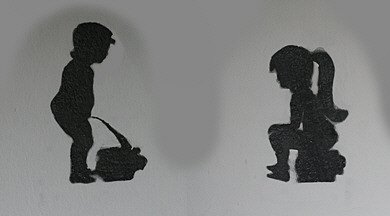
Following lunch, we were shown how carpets are woven, we were shown how the silk for weaving them is produced, we were given an excellent "lesson" in oriental carpets... what to look for, what the options are. After that, if anyone wanted to buy a carpet, that was okay, too... but there was no pressure. So... going through those...
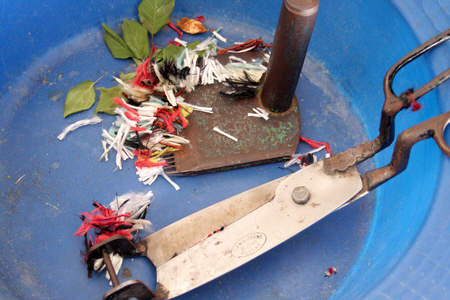
So... you (think) you'd like to weave an oriental carpet?
Get some linen or wool string for the warp. Set up your loom, with the warp running vertically. For a quite modest wool-on-wool carpet, 16 warp strings per inch is sufficient.
Apart from the frame to hold the warp strings, the tools you need are modest...
The scissors are a little special, to allow you to cut off the ends of threads, which "rise" perpendicular to the plane which will eventually be parallel to the floor... allow you to cut the threads so that the knap of the carpet is a uniform depth everywhere.
The other tool is like a bent comb. You use it from time to time to pound the row of knots you've done down tight against lower rows.
And then you need thread of silk or wool in various colors, and you start making knots. Lots and lots of knots. And be sure to use the right color thread for each one.
In the photo below, you can just make out the artist's ring at the upper right, to give you the scale. Upper left: Many warp strings, awaiting knots. Each knot engages just two of the warp strings, and results in two strands of the yarn rising "up" from the warp. We'll come to the details in a moment. What you see below is a number of completed knots which have not yet been trimmed.

Now let's look at how each knot is made.... in Turkish rug making. Each knot gives rise to two threads in the carpet's pile. There are other methods, not as robust... but easier, faster. ("Not as robust" according to Wikipedia, as well as to our Turkish guide!)
You pull up the next warp string, and wrap a bit of your pile yarn around it. You then get the adjacent warp string, and wrap the yarn around it. Pull down, and do a rough trim. And repeat. Many, many times.
Don't be confused by the roughly half inch gap between the warp strings... the weaver has pulled them apart, in order to wrap the pile yarn around them. They will snap back together as the knot is pulled tight.
In addition to that, there will also sometimes... usually?... be weft yarns (at right angles to the warp) woven into the carpet, entirely in the plane of the warp yarns, like "ordinary" woven cloth, to keep everyting tight and strong. You can see them in some of the photos below of the backs of carpets.

Carpets are made with wool or silk pile. And yes, the silk carpets, some of them, anyway, are meant for walking on. Of course, in mosques, at least, people remove their shoes before going indoors. The source of wool yarn isn't particularly mysterious, but what do you know about obtaining silk?
(To digress slightly: Linen may also be involved: as the material of the warp, when wool or silk isn't used.)
Silk starts as catepillar spit. The catepillars eat mulberry leaves, and eventually spin coccoons. Each coccoon is spun from a single continuous strand of silk... about 1200 yards long. If the coccoons are gently simmered in a bath of water, the adhesive in them softens, and the strand can be pulled free, like string off of a ball. The next photos show the overall apparatus, and a close up showing the strands from perhaps 30 coccoons being drawn together. In the overall view, you can see the "pot" where the coccoons bob in the warm water. Above them is the point where the strands are brought together, shown in the detail photo, and in the foreground is the apparatus onto which the strands are wound for drying.
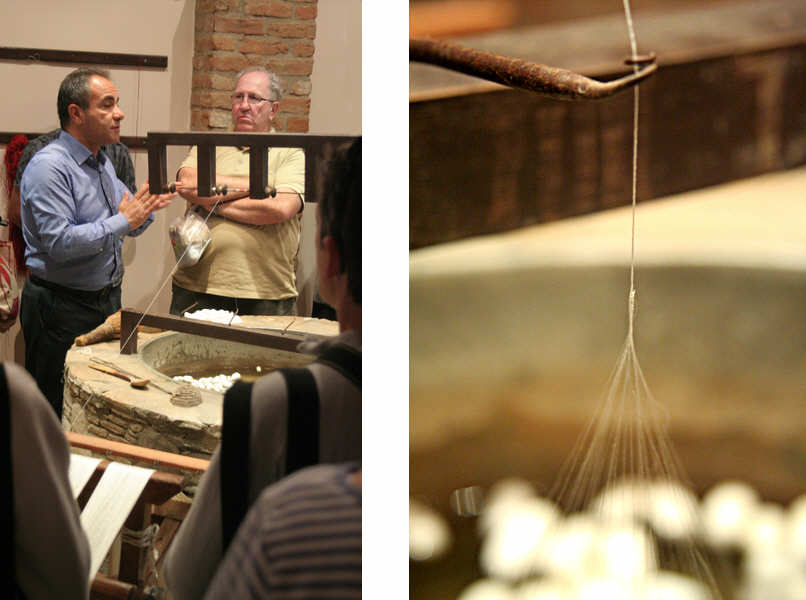
The gentleman in the blue shirt was our hard-working host, who conveyed a lot of information very clearly. It was obviously "a show" which had been performed many times... but it was performed diligently and with passion, and he encouraged questions and diversions from "the program". And, in the presentation I am about to describe, he had numerous helpers working hard, physically, rolling out carpet after carpet with great showmanship. (And then rolling them all up again, of course, after our enjoyment of them.)
Once dry, the silk is still not very nice... a bit like straw colored clean horse hair... still quite coarse. It needs washing and treatment to remove the last traces of the adhesive. And dyeing. But that's "all", to produce the yarn the weavers turn into carpets.
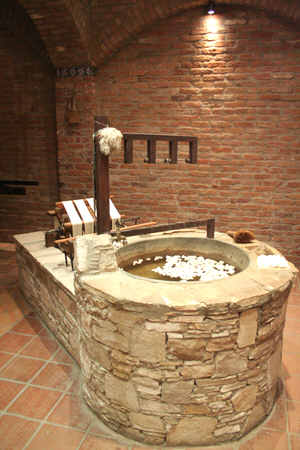
Perhaps this alternate view will help? Don't be confused by the fact that it is set up to harvest four lengths of yarn at once.
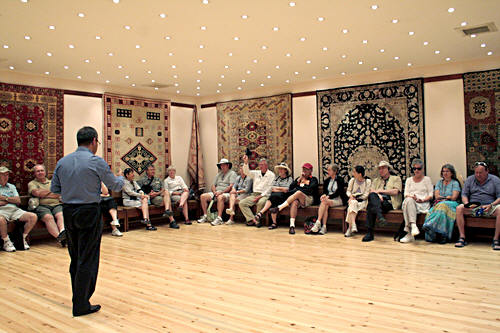
Here is what things looked like at the start of the presentation we had about Turkish carpets. I fear I had the white balance setting on my camera wrong for the room. The carpets on the walls were gorgeous, not the colors you see here.
The presenter was unstinting in asking his associates to roll out examples... usually multiple examples... of each point he made. As the presentation progressed, the floor was soon covered, and covered quite deeply. What I failed to photograph was the many carpets rolled up and piled around the periphery of the room.
So... why does one five square foot carpet, from an honest dealer, cost $200 and another $20,000? Here are the factors explained, with wonderful illustrations, to us....
Materials. The underlying warp may be linen, wool or silk.
The pile may be of wool or of silk. There is a special wool which gives the carpet a fascinating sheen, which changes with your point of view. (Angora wool? Something like that.) In another variation, weavers do the background in wool, and the foreground in silk. Running your hand across such a carpet, as we were encouraged to do, gives a lovely feeling.
Knot count. (I hope someone will check my arithmetic here... I should be doing other things, and have slightly rushed this.) As you double the number of knots per inch, you square the knots in the carpet overall. (Take a carpet for a hallway, 3 feet by 18 feet. At a simple 16 knots per inch (linear), that's 1.9 million knots. It can be a perfectly servicable, attractive carpet. But the design in it will be "low resolution" as a result of the small number of knots per inch.
The same size carpet, woven with only twice the resolution, 32 knots per inch, will require nearly 8 million knots... but a more detailled design will be possible. But for four times the work, you will have to expect to pay more, won't you?
Work it out... Allow 10 minutes break per hour, 5 hours of weaving per day. 20 knots per minute, which I would bet some of the weavers achieve, even with the trimming and "tamp down" overheads. That's still more than 75 five day weeks to create the 16 knots per inch hall carpet. Now do the prices being asked seem high? Would they be high for plain, one color carpets? Remember that they were things of considerable beauty, even if you don't stop to think about the weaving of them. It will be tragic if the art dies out... but you can see how it might?
32 knots per linear inch is 1024 knots per square inch. 3,200 knots per inch are sometimes used for silk- on- silk "carpets" as artwork... see below.
These photos are of the BACKS of two carpets, carpets with different knot densities. (The ring on my pen-knife is 12mm across.)

So... thse are some of the less obvious attributes which go to explain why some carpets are more expensive than others. Of course, there is also the more obvious matter of the artistic skill of the designer, and the complexity of the design. Is it a "simple" geometric pattern, or something more involved?
Here is a carpet about 26 inches by 40 inches in the style of a prayer rug. But this one, at 3,200 knots per square inch, silk on silk, is more a work of art, to be hung... carefully... on a wall (in a museum?), more a work of art than an article for everyday use. $78,000.
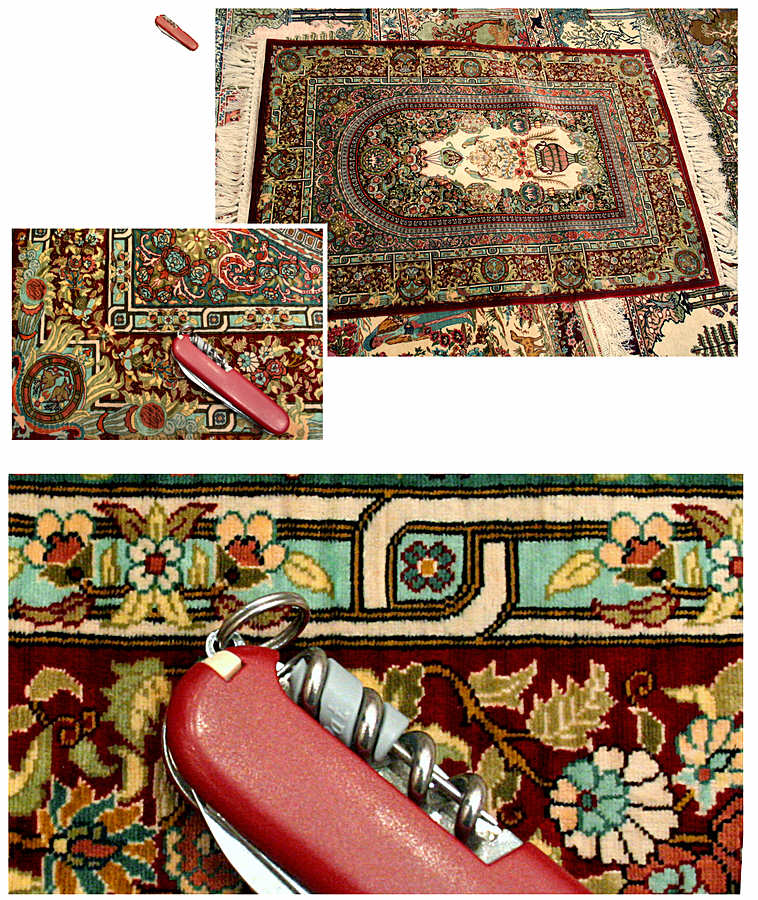
After the informative presentation, with no pressure at all, we were told that if we wanted to discuss buying a carpet (or two!), that was possible, too.
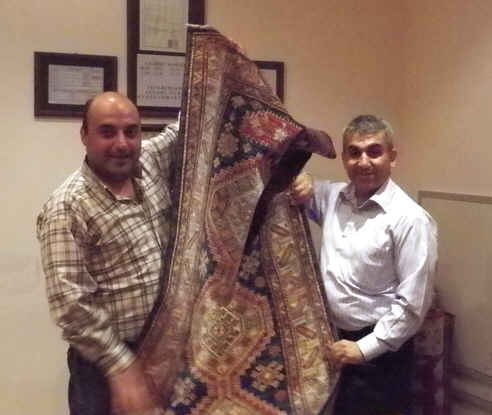
I had been desperately trying to document in photos the wonderful sights and information on offer, and missed a bit of what was being said when refreshment was being offered. Being a muslim country, and being just after lunch, a non-alcholic option was obviously available. I "woke up" as someone was asking "How many people would like..." stage... but hadn't heard what drink was currently being counted. But I saw our guide's hand up, so I thought, "Why not", and put my hand up. Mistake? I don't think so... but what I'd asked for was a local spirit, raki, anise (similar to liquorice) flavor, served warm. Very nice! But perhaps not the best thing to indulge in prior to a session with a carpet seller? No "regrets"... but I'd be even happier, if I had made my purchase with a completely clear head! Both carpet I bought and raki nice... but perhaps segregating the buying and the drinking would have been wiser?
Many members of our group set off to Kusadasi quite soon, in the first coach. Others stayed behind in the solicitous care of individual salesmen. Not only was nothing too much trouble, in terms of showing you things with more red, different design, different size, etc, etc, to your heart's content, but the arrangements for shipping, etc... and their "satisfaction guarantee" were excellent. I think it was "meant to be"... the salesman who assisted me was Suleyman, by name... same name as the builder of the mosque which was one of the specific treasures of Istanbul which helped me decide to go on this trip!
These pages written on an "old fashioned", non- widescreen system. It may enhance your enjoyment to view the pages in a window that doesn't use the full width of a widescreen display.
This page © TK Boyd 5/12. Click here to contact him.
You are also invited to Tom Boyd's homepage, including Windows software for schools, kids, and others.
Remember: This is one of the pages in the "chronological" sequence through my photos of the trip. Go back to the main page for my tour with Tauck, Athens to Istanbul, for other virtual tour options.
< < < Click here for previous page in "chronological" set Click here for next page in "chronological" set > > >
![]() Page tested for compliance with INDUSTRY (not MS-only) standards, using the free, publicly accessible validator at validator.w3.org.
Page tested for compliance with INDUSTRY (not MS-only) standards, using the free, publicly accessible validator at validator.w3.org.
- - - Page ends - - -